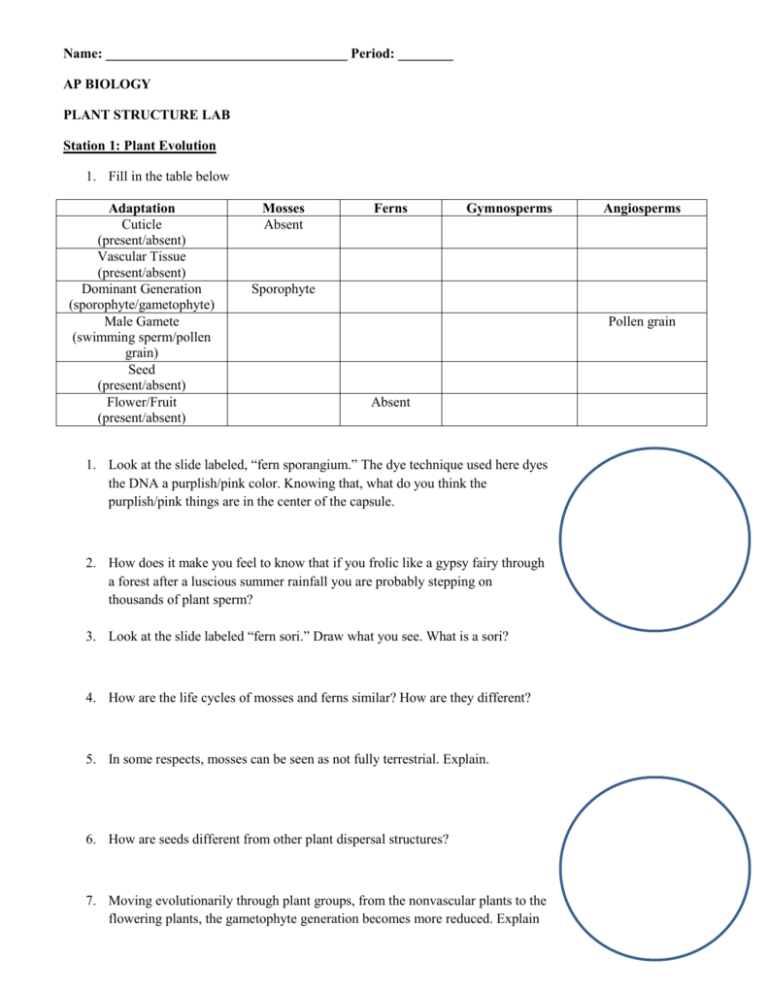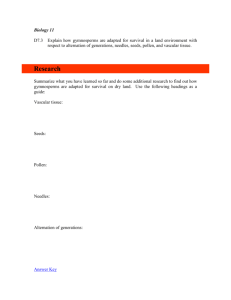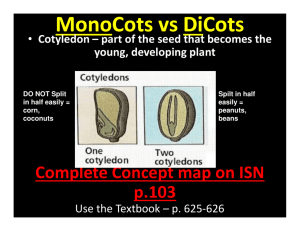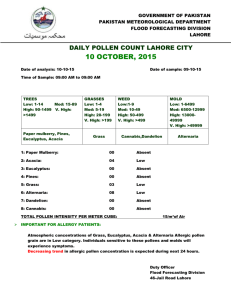Name: Period: ______ AP BIOLOGY PLANT STRUCTURE LAB
advertisement

Name: ___________________________________ Period: ________ AP BIOLOGY PLANT STRUCTURE LAB Station 1: Plant Evolution 1. Fill in the table below Adaptation Cuticle (present/absent) Vascular Tissue (present/absent) Dominant Generation (sporophyte/gametophyte) Male Gamete (swimming sperm/pollen grain) Seed (present/absent) Flower/Fruit (present/absent) Mosses Absent Ferns Gymnosperms Angiosperms Sporophyte Pollen grain Absent 1. Look at the slide labeled, “fern sporangium.” The dye technique used here dyes the DNA a purplish/pink color. Knowing that, what do you think the purplish/pink things are in the center of the capsule. 2. How does it make you feel to know that if you frolic like a gypsy fairy through a forest after a luscious summer rainfall you are probably stepping on thousands of plant sperm? 3. Look at the slide labeled “fern sori.” Draw what you see. What is a sori? 4. How are the life cycles of mosses and ferns similar? How are they different? 5. In some respects, mosses can be seen as not fully terrestrial. Explain. 6. How are seeds different from other plant dispersal structures? 7. Moving evolutionarily through plant groups, from the nonvascular plants to the flowering plants, the gametophyte generation becomes more reduced. Explain how this pattern with early plants’ move from aquatic, or at least moist, to terrestrial habitats. 8. Look at the slides labeled “Pine Young Ovuiate Cone” and “Pine Staminate Cone.” A staminate cone contains the male reproductive structures that produce microspores. An ovulate cone contains the female reproductive structures that produce megaspores. You can easily see the difference if looking at one of the outside “spikes” Draw what you see in each and try to label the megasporangium (general area in ovary) and megasporyte (dark purple “egg”) in the female structure and the microsporangium (pollen grains) in the male structure. 9. Pine trees, like most conifers, have female cones and male cones. Station 2: Roots 1. In the space provided, draw the onion root tip you see and label the main parts of the root including the root cap the apical meristem, and the zone of elongation. Also, write the function of each below. a. Root Cap: b. Apical Meristem: c. Zone of Elongation: 2. Why do you think the cells near the bottom have less nuclei than the ones in the middle? 3. What is the primary function of the shoot system? 4. What is the primary function of the root system? 5. Name the region that protects the zone of cell division (meristem). 6. What type of cell division occurs in the meristem – mitotic or meiotic? 7. What is the function of the root hairs? 8. Consider the structure of tap roots vs. fibrous roots. Which root system is more likely to enable a plant to withstand drought conditions when surface moisture is not readily available? Why? Station 3: Stems 1. Look at the slide labeled “Pine Older Stem” and draw what you see. Label the xylem, phloem, the epidermis, the vascular cambium, the pith, and the vascular bundle. Station 4: Leaves 1. Draw what you see on the slide labeled “Lily, leaf epidermis.” Label the stomata and the guard cells. 2. What is the function of stomata? 3. What is the name of the process in which water escapes from the stomata? 4. What is a monocot and a dicot? List all the differences you can find. Answer the Following Question: 6. On a sunny day, the closing of stomata in plant leaves results in (1999:52) a. a decrease in CO2 intake b. a shift from C3 photosynthesis to C4 photosynthesis c. an increase in transpiration d. an increase in the concentration of CO2 in mesophyll cells e. an increase in the rate of production of starch




